#Dwan icons
Text
(girl wgo feels like shit voice) i should rewatch the supernatural's i know what you did last summer .
#txt.toothdecay#most iconic episode it gave us everything#samruby. anna milton intro. sam stitching his arm. anna milton. samruby sex. sam and dwan jumping through a window . ANNA MILTON !!!!#migraine agh .... T_T tried to sleep it off didnt worrkkk
0 notes
Text
ok now walk with me for a second......famous actor!gojo and famous actress!reader are asked to go on lipsync battle and gojo does toms iconic umbrella performance and reader does jenna dwans pony performance? do you see my vision? please see my vision
11 notes
·
View notes
Text

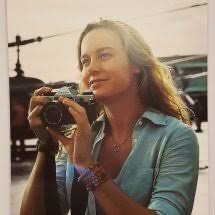
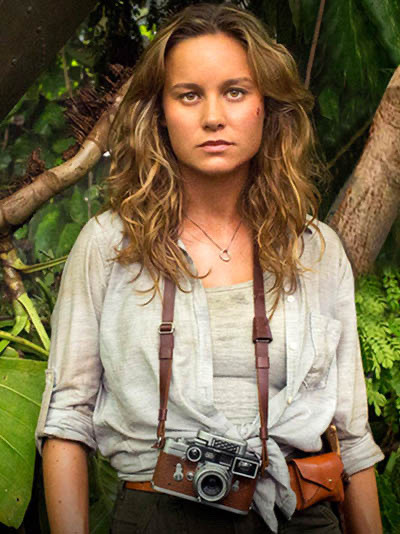

I personally really liked the character of Mason Weaver in Kong: Skull Island🦍 in fact I might actually prefer her to the likes of Ann Darrow/Dwan - she’s not some vapid damsel in distress running around barefoot, she has a legit reason for being on Skull Island and she and Kong don’t "fall in wuv" they bond over protecting the inhabitants of Skull Island - I wish more action movies had a heroine like her! She’s much more like Dr. Ellie Satler or Ellen Ripley than Ann Darrow. Anyway I was thinking about what would happen if her character were to make a return to the series and if so who would play her because obviously if it’s in the present day then they would need somebody older (although they could still use Brie for flashbacks)? Here are some ideas I had:
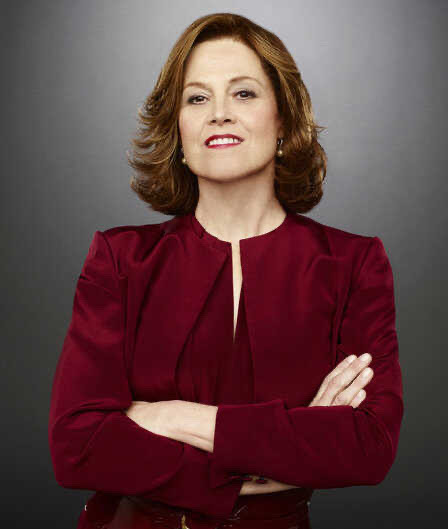
Sigourney Weaver - The character of Mason actually got her last name from the Alien icon so how could I not pick her!?

Jessica Lange - perhaps as a throwback to the 1976 version of the story we could once again have Ms. Lange as the object of the big guys affection?

Susan Sarandon - just because she’s a kickass actress, is around the right age, kinda looks like Brie and could believably play a former anti war photographer who’s probably dealing with some sort of PTSD. I would certainly watch that movie!!

Helen Mirren - for similar reasons to Ms. Sarandon. Plus with her razor sharp wit and dry humour she could keep things real without it getting too sappy. Once again I would watch that movie!
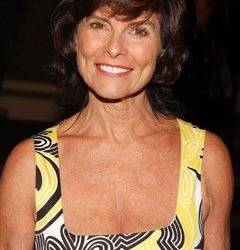
Adrienne Barbeau - This woman absolutely ruled the 1980s sci-fi scene and kicked ass while doing so! She mostly does TV roles now but I bet she would fit right into the Monsterverse!
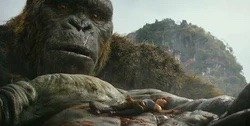
Anyways that’s just my opinion. What do you guys think?
#monsterverse#king kong#kong skull island#mason weaver#brie larson#heroine#girls kick butt too#nasty gal#jessica lange#susan sarandon#helen mirren
11 notes
·
View notes
Text
AM Radio Remains Strong in Philippine Media
Newly relaunched AM radio station DWAN 1206 AM takes headline
DWAN 1206 AM Shakes Up AM Radio Band in Manila, Philippines
DWAN 1206 AM, the iconic radio station that once graced the airwaves of Metro Manila, is making a triumphant comeback. After years of silence, this beloved station is set to reclaim its place as a trusted source of news, talk shows, and entertainment.
A Rich History
DWAN…

View On WordPress
0 notes
Text
KING KONG (1976)

KING KONG (1976) Starring Jeff Bridges, Charles Grodin, Jessica Lange Directed by Directed by John Guillermin
"King Kong" is a remake of the classic 1933 film of the same name, but with a modern twist (for the time, of course). Directed by John Guillermin and produced by Dino De Laurentiis, the film tells the story of Fred Wilson (Charles Grodin), an oil executive who leads an expedition to a remote island in search of valuable mineral deposit. Jack Prescott (Jeff Bridges) is a primate paleontologist that comes along for the ride. Along the way, they encounter a giant ape named Kong (portrayed by Rick Baker in an awesome gorilla suit), who becomes smitten with Wilson's leading lady, Dawn (Jessica Lang)...and no, I didn't spell that incorrectly btw.

One of the standout features of "King Kong" is the special effects. While the original 1933 film used stop-motion animation to bring the iconic ape to life, the 1976 remake used a combination of animatronics and Baker's performance in a gorilla suit. Although some of the effects may seem dated by today's standards, they were cutting-edge at the time and still hold up reasonably well.
Another notable aspect of the film is the chemistry between Grodin and Lange. Grodin plays the villainous oil executive to near perfection, while Lange brings a fresh and youthful energy to the role of Dwan. The scenes between her and Kong are some of the film's most memorable, and Lange's performance helped launch her career as a Hollywood leading lady.

Despite its strengths, "King Kong" has its fair share of flaws. The pacing can be slow at times, and the film's overall tone can be somewhat uneven. Additionally, some of the characterizations are stereotypical or underdeveloped, which can make it difficult to fully invest in the story.
Overall, "King Kong" is an enjoyable adventure film that offers plenty of thrills and entertainment. While it may not be as iconic as the 1933 original, it's still a fun and worthwhile entry in the King Kong franchise.

#king kong#movie review#blog writing#blogger#old movies#classic movies#classic film#film review#reviews#bloggingcommunity#blogging#classic
1 note
·
View note
Text



💭 '' § : Podia ter sido tudo tão diferente. Se não tivesses aparecido à minha frente. Tu mudaste a minha vida pra melhor. Agora sei, agora sei que só estou bem assim...



#Harumi-web new post!#Kim Hyuna#Kim Hyojong#Hyuna e Dwan#Solo moodboard#Soloist moodboard#Hyuna moodboard#Dwan moodboard#Hyuna e Dawn moodboard#Grunge moodboard#Messy moodboard#Indie moodboard#Edgy moodboard#Messy icona#Solo icons#Soloist icons#Hyuna icons#Dwan icons#Amino packs#Hyuna#Dwan#Solo#Soloist#Ilysm :)
474 notes
·
View notes
Text









(。・ω・。)ノ♡-> hyuna and dawn (<3) moodboard!
♡ like, reblog and follow!!
#hyuna layouts#hyuna lq icons#dawn layouts#dawn lq icons#messy layouts#messy headers#random layouts#ullzang layouts#icons#kpop#kpop icons#lq icons#girls icons#hyuna icons#dawn icons#hyojong icons#Solo moodboard#Soloist moodboard#Hyuna moodboard#Dwan moodboard#Hyuna e Dawn moodboard#Grunge moodboard#Messy moodboard#Indie moodboard#Edgy moodboard#Messy icona#Solo icons#Soloist icons
124 notes
·
View notes
Photo









⤷ 𝘭𝘪𝘬𝘦 𝘰𝘳 𝘳𝘦𝘣𝘭𝘰𝘨 𝘪𝘧 𝘺𝘰𝘶 𝘴𝘢𝘷𝘦 ⭑ 𝘥𝘰𝘯'𝘵 𝘳𝘦𝘱𝘰𝘴𝘵!
#dawn#dawn icons#edawn#edawn icons#kim hyojong#kim hyojong icons#hyojong#hyojong icons#pentagon#pentagon dwan#pentagon dawn icons#pentagon edawn#pentagon kim hyojong#pentagon icons
78 notes
·
View notes
Photo








♡ ⠀ :⠀ Hyuna⠀⎘⠀⠀¡⠀⠀ᘡ⠀ icons⠀⠀ !
10 notes
·
View notes
Photo

Gloria Swanson in the Alan Dwan Production ‘The Coast of Folly’ 1924.
#silent film#silent era#gloria swanson#silent idol#silent film icon#silent movie stars#hollywood greats#old hollywood#hollywood icon#alan dwan#1920s#1924#stummfilm#the coast of folly
41 notes
·
View notes
Text



Complemento desse moodboard!



⠀⠀⠀⠀.. く ﹚̤♡⃨ Kim kyojong/Dwan
⠀ ⠀་🧸ꫬ໋ ⠀Icon + Fundo﹚̤♡⃨ ⠀Solista ▒𓂅⃨
⠀ ⠀ ⠀ ⠀﹙𝐸﹚﹫luluas-things ⠀ ▒⃞⃮ 👑 ⠀⠀ᩧ
⠀⠀⠀⠀⠀⠀▒₊ ♡⃨ ︙ love yourself⠀▒⋮ Ꜣ 🦋⠀ ᷧ▒̈
⠀ ⠀ ⠀Coloca o crédito se for usar por favor!
#kim hyojong#solist moodboard#messy moodboard#amino packs#messy icons#soft icons#icons moodboard#soft moodboard#soft messy#moodboard#kpop#hyundawn
29 notes
·
View notes
Text
Blu-ray Review: King Kong (1976)
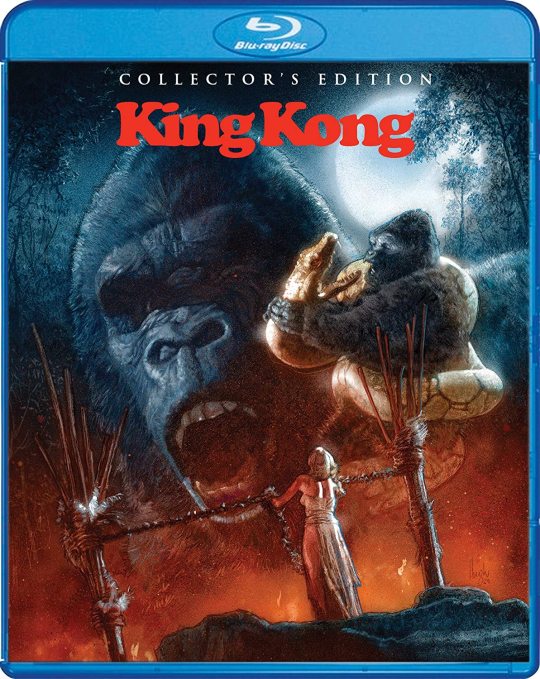
The recent release of Godzilla vs. Kong revived the age-old debate about which giant monster is superior, but it's not exactly a fair fight when you consider their respective quantity of output. By the mid-1970s, Godzilla had already appeared in 15 films, while King Kong only had a mere four to his name: the 1933 original, its same-year sequel Son of Kong, the 1962 crossover King Kong vs. Godzilla, and its 1967 followup King Kong Escapes.
The first remake of King Kong arrived in 1976 at the behest of Italian producer Dino De Laurentiis (Dune, Flash Gordon, Army of Darkness). Lorenzo Semple Jr. (Flash Gordon) was hired to pen the script, based on James Ashmore Creelman and Ruth Rose's original screenplay, and John Guillermin (The Towering Inferno, Death on the Nile) assumed the director's chair. Richard H. Kline (Star Trek: The Motion Picture, Soylent Green) served as cinematographer, while John Barry (Dances with Wolves, Goldfinger) composed the score. The plot largely follows the same beats as the 1933 version, although some alterations and expansions were made along the way.
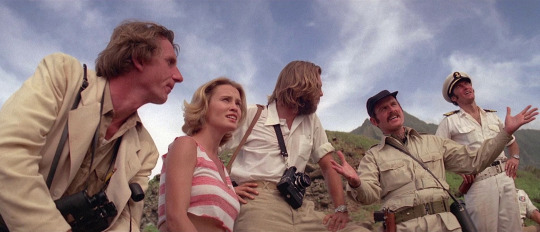
Hoping to sail into the history books with the biggest oil strike in history, oil magnate Fred Wilson (Charles Grodin, Midnight Run) leads an expedition to an undiscovered island in the Indian Ocean hidden by a perpetual fog. Paleontologist Jack Prescott (Jeff Bridges, The Big Lebowski) sneaks aboard the vessel, as he believes an animal occupies the island. In the middle of the ocean, the ship happens upon a life raft with struggling actress Dwan (Jessica Lange, American Horror Story), who quickly hits it off with Jack. Upon arriving at its destination, the crew discovers that the island is not uninhabited when they interrupt the native's ritual. The tribesmen proceed to kidnap Dwan and offer her as a sacrifice to the giant primate known as Kong.
The big reveal is impressive considering the limitations of the time. Per the closing title card, Kong was designed and engineered by Carlo Rambaldi (E.T. the Extra-Terrestrial, Alien), who also constructed it with Glen Robinson (Logan's Run, Flash Gordon), with “special contributions” by Rick Baker (An American Werewolf in London, Men in Black). Since Rambaldi's attempt at a full-scale electronic Kong failed, however, the majority of creature work is accomplished with Baker in a costume with mechanized masks. It's fairly convincing as such, although the seams of the composite shots are clearly visible in high definition. Perhaps more than any other kaiju, it's important for Kong to be expressive, and this iteration successfully conveys pathos.

Semple's script drops the filmmaking angle from the original plot yet retains that the female lead is an aspiring actress and the human antagonist wants to exploit Kong on stage - which, smartly, becomes a corporate-branded event here. Kong only fights one monster on the island - a bloody battle with a giant snake - but his path of destruction in New York is much grander, rivaling and often upstaging the Godzilla films of the time. Instead of the Empire State Building, Kong is drawn to the then-new World Trade Center this time around, as the Twin Towers parallel his habitat, leading to his tragic downfall and a brilliant final image.
After Barbra Streisand passed on the role of Dwan, De Laurentiis sought to pluck an unknown actress from obscurity and make her a star. He did just that with Lange, who receives an "introducing" credit. It's easy to see why she won out over innumerable other aspiring actresses, as she radiates on camera, and her naivety works to the advantage of her character. Bridges is serviceable as the leading man and has good chemistry with Lange - but the film's focus is, rightly, on Kong and Dwan. Their bond is palpable, although the sexualization of their relationship is an odd choice.
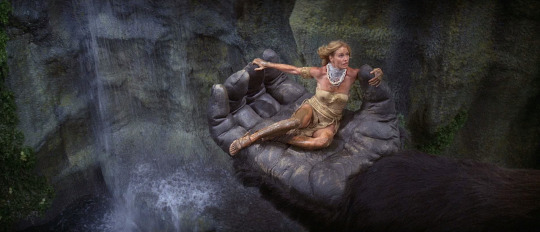
While the supporting roles are largely one-dimensional, they're filled by a number of keen character actors: John Randolph (Christmas Vacation) as the ship's captain, Ed Lauter (Family Plot) as the first mate, Rene Auberjonois (Star Trek: Deep Space Nine) as a geologist, Jack O'Halloran (Superman) and Julius Harris (Live and Let Die) as oil drillers, Dennis Fimple (House of 1000 Corpses) as a crew member, John Lone (The Last Emperor) as the cook, John Agar (Revenge of the Creature) as a city official, Walt Gorney (Friday the 13th) as a subway driver, and a young Corbin Bernsen (Psych) and Joe Piscopo (Saturday Night Live) as uncredited reporters.
King Kong has been released on Collector's Edition Blu-ray by Scream Factory with reversible artwork featuring a new design by Hugh Fleming and John Berkey's classic poster. The two-disc set includes the 134-minute theatrical version and the 182-minute TV cut, with its additional footage newly scanned in 2K from the internegative. (NBC paid De Laurentiis $19.5 million for two showings; the highest amount a network ever paid for a film at the time.) It features DTS-HD 5.1 and newly restored theatrical DTS-HD 2.0 stereo audio options.
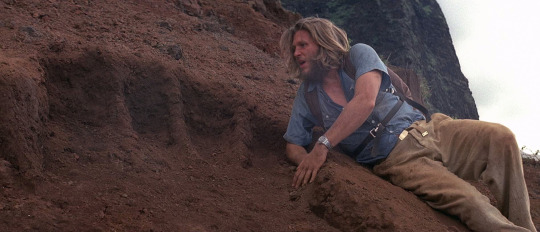
This version of King Kong lacks the awe-inspiring spectacle of the three other major iterations (the 1933 original, Peter Jackson's 2005 remake, and 2017's Kong: Skull Island reboot), but it has moments of greatness that shine in high definition. De Laurentiis successfully spearheaded a sincere remake that shows reverence for the cinematic icon, and the theatrical cut is smoothly paced despite the lengthy runtime. The TV version doesn't fare as well, as it's padded by nearly an hour of additional footage (along with trims to the more crude sequences). They do little to add plot points, character depth, or anything else of potential value; instead they serve only to fill a programming block at the expense of the pacing. Still, it's nice to finally have a restored version for diehard fans.
King Kong: The History of a Movie Icon author Ray Morton provides a new audio commentary on the theatrical cut. It's very dry but full of information, especially when it comes to the drama between Rambaldi and Baker over the creature design. Having "outgrown the boundaries of a featurette," per disc producer Justin Beahm, an interview with Baker was turned into a second commentary. It's not as long as the whole film, which is fine, but it frustratingly forces the viewer to sit through gaps of the film's audio while awaiting the next soundbite rather than presenting it all in succession. It's unfortunate but worthwhile, as there's a lot of firsthand insight.

Beyond that, there are over 45 minutes of new video interviews with O’Halloran, assistant director David McGiffert, production manager Brian Frankish, sculptor Jack Varner, second unit director William Kronick, photographic effects assistant Barry Nolan, and production assistants Jeffrey Chernov and Scott Thaler. Most are conducted over video chat with mostly fine results (O’Halloran's picture quality is particularly bad), although a few are traditional on-camera pieces, and some subjects are paired together. They all seem proud of their contributions and happily share anecdotes about working on the massive production, even if the experiences weren't always positive.
Other special features on the first disc include the theatrical trailer, seven TV spots, three radio spots, and four still galleries (stills, posters and lobby cards, newspaper ads, and behind-the-scenes photos). The TV cut disc, meanwhile, sports an hour-long panel with Baker, O’Halloran, Kline, Dino De Laurentiis' widow Martha, and Barry's agent Richard Kraft, from a 2016 event at Santa Monica, CA's Aero Theater. Hosted by Morton, it's an entertaining and informative discussion.
King Kong is available on Collector’s Edition Blu-ray now via Scream Factory.
#king kong#kong#jeff bridges#jessica lange#rick baker#carlo rambaldi#scream factory#dvd#gift#review#article#john guillermin#dino de laurentiis#kaiju#king kong 1976
22 notes
·
View notes
Photo

ok had 2 put this here bc margaret atwood + lisa dwan met + i'm crying abt it
#2 of my faves ??? casually met in toronto???#iconic thanks lov it#margaret atwood#lisa dwan#rambles
5 notes
·
View notes
Note
olá de novo, é a daan... enfim eu quetia perguntar se você faz capas de fanfic.... desculpa o incomodo novamente... amo muito seu blog será que poderia fazer icons da Jessi ou da Hyuna com o Dwan? por favor, desde já agradeço💙
Não faço anjo, apenas icons e locks. Fiz alguns icons da Jessi 💌💕
7 notes
·
View notes
Text

Carole Lombard (born Jane Alice Peters; October 6, 1908 – January 16, 1942) was an American actress, particularly noted for her energetic, often off-beat roles in screwball comedies. She was the highest-paid star in Hollywood in the late 1930s and in 1999, the American Film Institute ranked Lombard 23rd on its list of the greatest female stars of Classic Hollywood Cinema.
Lombard was born into a wealthy family in Fort Wayne, Indiana, but was raised in Los Angeles by her single mother. At 12, she was recruited by director Allan Dwan and made her screen debut in A Perfect Crime (1921). Eager to become an actress, she signed a contract with the Fox Film Corporation at age 16, but mainly played bit parts. She was dropped by Fox just before her 18th birthday after a shattered windshield from a car accident left a scar on her face. Lombard appeared in fifteen short comedies for Mack Sennett between 1927 and 1929, and then began appearing in feature films such as High Voltage (1929) and The Racketeer (1929). After a successful appearance in The Arizona Kid (1930), she was signed to a contract with Paramount Pictures.
Paramount quickly began casting Lombard as a leading lady, primarily in drama films. Her profile increased when she married William Powell in 1931, but the couple divorced amicably after two years. A turning point in Lombard's career came when she starred in Howard Hawks's pioneering screwball comedy Twentieth Century (1934). The actress found her niche in this genre, and continued to appear in films such as Hands Across the Table (1935) (forming a popular partnership with Fred MacMurray), My Man Godfrey (1936), for which she was nominated for the Academy Award for Best Actress, and Nothing Sacred (1937). At this time, Lombard married "The King of Hollywood", Clark Gable, and the supercouple gained much attention from the media. Keen to win an Oscar, Lombard began to move towards more serious roles at the end of the decade. Unsuccessful in this aim, she returned to comedy in Alfred Hitchcock's Mr. & Mrs. Smith (1941) and Ernst Lubitsch's To Be or Not to Be (1942), her final film role.
Lombard's career was cut short when she died at the age of 33 aboard TWA Flight 3, which crashed on Mount Potosi, Nevada, while returning from a war bond tour. Today, she is remembered as one of the definitive actresses of the screwball comedy genre and American comedy, and icon of American cinema.
Lombard was born in Fort Wayne, Indiana, on October 6, 1908 at 704 Rockhill Street. Christened with the name Jane Alice Peters, she was the third child and only daughter of Frederick Christian Peters (1875–1935) and Elizabeth Jayne "Bessie" (Knight) Peters (1876–1942). Her two older brothers, to each of whom she was close, both growing up and in adulthood, were Frederick Charles (1902–1979) and John Stuart (1906–1956). Lombard's parents both descended from wealthy families and her early years were lived in comfort, with the biographer Robert Matzen calling it her "silver spoon period". The marriage between her parents was strained, however, and in October 1914, her mother took the children and moved to Los Angeles. Although the couple did not divorce, the separation was permanent. Her father's continued financial support allowed the family to live without worry, if not with the same affluence they had enjoyed in Indiana, and they settled into an apartment near Venice Boulevard in Los Angeles.
Described by her biographer Wes Gehring as "a free-spirited tomboy", the young Lombard was passionately involved in sports and enjoyed watching movies. At Virgil Junior High School, she participated in tennis, volleyball, and swimming, and won trophies for her achievements in athletics. At the age of 12, this hobby unexpectedly landed Lombard her first screen role. While playing baseball with friends, she caught the attention of the film director Allan Dwan, who later recalled seeing "a cute-looking little tomboy ... out there knocking the hell out of the other kids, playing better baseball than they were. And I needed someone of her type for this picture." With the encouragement of her mother, Lombard happily took a small role in the melodrama A Perfect Crime (1921). She was on set for two days, playing the sister of Monte Blue. Dwan later commented, "She ate it up".
A Perfect Crime was not widely distributed, but the brief experience spurred Lombard and her mother to look for more film work. The teenager attended several auditions, but none was successful.[11] While appearing as the queen of Fairfax High School's May Day Carnival at the age of 15, she was scouted by an employee of Charlie Chaplin and offered a screen test to appear in his film The Gold Rush (1925). Lombard was not given the role, but it raised Hollywood's awareness of the aspiring actress. Her test was seen by the Vitagraph Film Company, which expressed an interest in signing her to a contract. Although this did not materialize, the condition that she adopt a new first name ("Jane" was considered too dull) lasted with Lombard throughout her career. She selected the name "Carol" after a girl with whom she played tennis in middle school.
In October 1924, shortly after these disappointments, 16-year-old Lombard was signed to a contract with the Fox Film Corporation. How this came about is uncertain: in her lifetime, it was reported that a director for the studio scouted her at a dinner party, but more recent evidence suggests that Lombard's mother contacted Louella Parsons, the gossip columnist, who then got her a screen test. According to the biographer Larry Swindell, Lombard's beauty convinced Winfield Sheehan, head of the studio, to sign her to a $75-per-week contract. The teenager abandoned her schooling to embark on this new career. Fox was happy to use the name Carol, but unlike Vitagraph, disliked her surname. From this point, she became "Carol Lombard", the new name taken from a family friend.
The majority of Lombard's appearances with Fox were bit parts in low-budget Westerns and adventure films. She later commented on her dissatisfaction with these roles: "All I had to do was simper prettily at the hero and scream with terror when he battled with the villain." She fully enjoyed the other aspects of film work, however, such as photo shoots, costume fittings, and socializing with actors on the studio set. Lombard embraced the flapper lifestyle and became a regular at the Coconut Grove nightclub, where she won several Charleston dance competitions.
In March 1925, Fox gave Lombard a leading role in the drama Marriage in Transit, opposite Edmund Lowe. Her performance was well received, with a reviewer for Motion Picture News writing that she displayed "good poise and considerable charm." Despite this, the studio heads were unconvinced that Lombard was leading lady material, and her one-year contract was not renewed. Gehring has suggested that a facial scar she obtained in an automobile accident was a factor in this decision. Fearing that the scar—which ran across her cheek—would ruin her career, the 17-year-old had an early plastic surgery procedure to make it less visible. For the remainder of her career, Lombard learned to hide the mark with make-up and careful lighting.
After a year without work, Lombard obtained a screen test for the "King of Comedy" Mack Sennett. She was offered a contract, and although she initially had reservations about performing in slapstick comedies, the actress joined his company as one of the "Sennett Bathing Beauties". She appeared in 15 short films between September 1927 and March 1929, and greatly enjoyed her time at the studio. It gave Lombard her first experiences in comedy and provided valuable training for her future work in the genre. In 1940, she called her Sennett years "the turning point of [my] acting career."
Sennett's productions were distributed by Pathé Exchange, and the company began casting Lombard in feature films. She had prominent roles in Show Folks and Ned McCobb's Daughter (both 1928), where reviewers observed that she made a "good impression" and was "worth watching". The following year, Pathé elevated Lombard from a supporting player to a leading lady. Her success in Raoul Walsh's picture Me, Gangster (also 1928), opposite June Collyer and Don Terry on his film debut, finally eased the pressure her family had been putting on her to succeed. In Howard Higgin's High Voltage (1929), her first talking picture, she played a criminal in the custody of a deputy sheriff, both of whom are among bus passengers stranded in deep snow. Her next film, the comedy Big News (1929), cast her opposite Robert Armstrong and was a critical and commercial success. Lombard was reunited with Armstrong for the crime drama The Racketeer, released in late 1929. The review in Film Daily wrote, "Carol Lombard proves a real surprise, and does her best work to date. In fact, this is the first opportunity she has had to prove that she has the stuff to go over."
Lombard returned to Fox for a one-off role in the western The Arizona Kid (1930). It was a big release for the studio, starring the popular actor Warner Baxter, in which Lombard received third billing. Following the success of the film, Paramount Pictures recruited Lombard and signed her to a $350-per-week contract, gradually increasing to $3,500 per week by 1936. They cast her in the Buddy Rogers comedy Safety in Numbers (also 1930), and one critic observed of her work, "Lombard proves [to be] an ace comedienne." For her second assignment, Fast and Loose (also 1930) with Miriam Hopkins, Paramount mistakenly credited the actress as "Carole Lombard". She decided she liked this spelling and it became her permanent screen name.
Lombard appeared in five films released during 1931, beginning with the Frank Tuttle comedy It Pays to Advertise. Her next two films, Man of the World and Ladies Man, both featured William Powell, Paramount's top male star. Lombard had been a fan of the actor before they met, attracted to his good looks and debonair screen persona, and they were soon in a relationship. The differences between the pair have been noted by biographers: she was 22, carefree, and famously foul-mouthed, while he was 38, intellectual, and sophisticated. Despite their disparate personalities, Lombard married Powell on June 6, 1931, at her Beverly Hills home. Talking to the media, she argued for the benefits of "love between two people who are diametrically different", claiming that their relationship allowed for a "perfect see-saw love".
The marriage to Powell increased Lombard's fame, while she continued to please critics with her work in Up Pops the Devil and I Take this Woman (both 1931). In reviews for the latter film, which co-starred Gary Cooper, several critics predicted that Lombard was set to become a major star. She went on to appear in five films throughout 1932. No One Man and Sinners in the Sun were not successful, but Edward Buzzell's romantic picture Virtue was well received. After featuring in the drama No More Orchids, Lombard was cast as the wife of a con artist in No Man of Her Own. Her co-star for the picture was Clark Gable, who was rapidly becoming one of Hollywood's top stars. The film was a critical and commercial success, and Wes Gehring writes that it was "arguably Lombard's finest film appearance" to that point. It was the only picture that Gable and Lombard, future husband and wife, made together. There was no romantic interest at this time, however, as she recounted to Garson Kanin: "[we] did all kinds of hot love scenes ... and I never got any kind of tremble out of him at all".
In August 1933, Lombard and Powell divorced after 26 months of marriage, although they remained very good friends until the end of Lombard's life. At the time, she blamed it on their careers, but in a 1936 interview, she admitted that this "had little to do with the divorce. We were just two completely incompatible people". She appeared in five films that year, beginning with the drama From Hell to Heaven and continuing with Supernatural, her only horror vehicle. After a small role in The Eagle and the Hawk, a war film starring Fredric March and Cary Grant, she starred in two melodramas: Brief Moment, which critics enjoyed, and White Woman, where she was paired with Charles Laughton. “We would have married,” said Carole Lombard during her interview with magazine writer Sonia Lee for Movie Screen Magazine in 1934 about her relationship with Russ Columbo, the famous singer killed in a tragic accident whose movie and radio career she had been guiding.
The year 1934 marked a high point in Lombard's career. She began with Wesley Ruggles's musical drama Bolero, where George Raft and she showcased their dancing skills in an extravagantly staged performance to Maurice Ravel's "Boléro". Before filming began, she was offered the lead female role in It Happened One Night, but turned it down because of scheduling conflicts with this production Bolero was favorably received, while her next film, the musical comedy We're Not Dressing with Bing Crosby, was a box-office hit.
Lombard was then recruited by the director Howard Hawks, a second cousin, to star in his screwball comedy film Twentieth Century which proved a watershed in her career and made her a major star. Hawks had seen the actress inebriated at a party, where he found her to be "hilarious and uninhibited and just what the part needed", and she was cast opposite John Barrymore. In Twentieth Century, Lombard played an actress who is pursued by her former mentor, a flamboyant Broadway impresario. Hawks and Barrymore were unimpressed with her work in rehearsals, finding that she was "acting" too hard and giving a stiff performance. The director encouraged Lombard to relax, be herself, and act on her instincts. She responded well to this tutoring, and reviews for the film commented on her unexpectedly "fiery talent"—"a Lombard like no Lombard you've ever seen". The Los Angeles Times' critic felt that she was "entirely different" from her formerly cool, "calculated" persona, adding, "she vibrates with life and passion, abandon and diablerie".
The next films in which Lombard appeared were Henry Hathaway's Now and Forever (1934), featuring Gary Cooper and the new child star Shirley Temple, and Lady by Choice (1934), which was a critical and commercial success. The Gay Bride (1934) placed her opposite Chester Morris in a gangster comedy, but this outing was panned by critics. After reuniting with George Raft for another dance picture, Rumba (1935), Lombard was given the opportunity to repeat the screwball success of Twentieth Century. In Mitchell Leisen's Hands Across the Table (1935), she portrayed a manicurist in search of a rich husband, played by Fred MacMurray. Critics praised the film, and Photoplay's reviewer stated that Lombard had reaffirmed her talent for the genre. It is remembered as one of her best films, and the pairing of Lombard and MacMurray proved so successful that they made three more pictures together.
Lombard's first film of 1936 was Love Before Breakfast, described by Gehring as "The Taming of the Shrew, screwball style". In William K. Howard's The Princess Comes Across, her second comedy with MacMurray, she played a budding actress who wins a film contract by masquerading as a Swedish princess. The performance was considered a satire of Greta Garbo, and was widely praised by critics. Lombard's success continued as she was recruited by Universal Studios to star in the screwball comedy My Man Godfrey (1936). William Powell, who was playing the eponymous Godfrey, insisted on her being cast as the female lead; despite their divorce, the pair remained friendly and Powell felt she would be perfect in the role of Irene, a zany heiress who employs a "forgotten man" as the family butler. The film was directed by Gregory LaCava, who knew Lombard personally and advised that she draw on her "eccentric nature" for the role. She worked hard on the performance, particularly with finding the appropriate facial expressions for Irene. My Man Godfrey was released to great acclaim and was a box office hit. It received six nominations at the 9th Academy Awards, including Lombard for Best Actress. Biographers cite it as her finest performance, and Frederick Ott says it "clearly established [her] as a comedienne of the first rank."
By 1937, Lombard was one of Hollywood's most popular actresses, and also the highest-paid star in Hollywood following the deal which Myron Selznick negotiated with Paramount that brought her $450,000, more than five times the salary of the U.S. President. As her salary was widely reported in the press, Lombard stated that 80 percent of her earnings went in taxes, but that she was happy to help improve her country. The comments earned her much positive publicity, and President Franklin D. Roosevelt sent her a personal letter of thanks.
Her first release of the year was Leisen's Swing High, Swing Low, a third pairing with MacMurray. The film focused on a romance between two cabaret performers, and was a critical and commercial success. It had been primarily a drama, with occasional moments of comedy, but for her next project, Nothing Sacred, Lombard returned to the screwball genre. Producer David O. Selznick, impressed by her work in My Man Godfrey, was eager to make a comedy with the actress and hired Ben Hecht to write an original screenplay for her. Nothing Sacred, directed by William Wellman and co-starring Fredric March, satirized the journalism industry and "the gullible urban masses". Lombard portrayed a small-town girl who pretends to be dying and finds her story exploited by a New York reporter. Marking her only appearance in Technicolor, the film was highly praised and was one of Lombard's personal favorites.
Lombard continued with screwball comedies, next starring in what Swindell calls one of her "wackiest" films, True Confession (1937). She played a compulsive liar who wrongly confesses to murder. Lombard loved the script and was excited about the project, which reunited her with John Barrymore and was her final appearance with MacMurray. Her prediction that it "smacked of a surefire success" proved accurate, as critics responded positively and it was popular at the box office.
True Confession was the last film Lombard made on her Paramount contract, and she remained an independent performer for the rest of her career. Her next film was made at Warner Bros., where she played a famous actress in Mervyn LeRoy's Fools for Scandal (1938). The comedy met with scathing reviews and was a commercial failure, with Swindell calling it "one of the most horrendous flops of the thirties".
Fools for Scandal was the only film Lombard made in 1938. By this time, she was devoted to a relationship with Clark Gable. Four years after their teaming on No Man of Her Own, the pair had reunited at a Hollywood party and began a romance early in 1936. The media took great interest in their partnership and frequently questioned if they would wed. Gable was separated from his wife, Rhea Langham, but she did not want to grant him a divorce. As his relationship with Lombard became serious, Langham eventually agreed to a settlement worth half a million dollars. The divorce was finalized in March 1939, and Gable and Lombard eloped in Kingman, Arizona, on March 29. The couple, both lovers of the outdoors, bought a 20-acre ranch in Encino, California, where they kept barnyard animals and enjoyed hunting trips. Almost immediately, Lombard wanted to start a family, but her attempts failed; after two miscarriages and numerous trips to fertility specialists, she was unable to have children. In early 1938, Lombard officially joined the Baháʼí Faith, of which her mother had been a member since 1922.
While continuing with a slower work-rate, Lombard decided to move away from comedies and return to dramatic roles. She appeared in a second David O. Selznick production, Made for Each Other (1939), which paired her with James Stewart to play a couple facing domestic difficulties. Reviews for the film were highly positive, and praised Lombard's dramatic effort; financially, it was a disappointment. Lombard's next appearance came opposite Cary Grant in the John Cromwell romance In Name Only (1939), a credit she personally negotiated with RKO Radio Pictures upon hearing of the script and Grant's involvement. The role mirrored her recent experiences, as she played a woman in love with a married man whose wife refuses to divorce. She was paid $150,000 for the film, continuing her status as one of Hollywood's highest-paid actresses, and it was a moderate success.
Lombard was eager to win an Academy Award, and selected her next project—from several possible scripts—with the expectation that it would bring her the trophy. Vigil in the Night (1940), directed by George Stevens, featured Lombard as a nurse who faces a series of personal difficulties. Although the performance was praised, she did not get her nomination, as the sombre mood of the picture turned audiences away and box-office returns were poor. Despite the realization that she was best suited to comedies, Lombard completed one more drama: They Knew What They Wanted (1940), co-starring Charles Laughton, which was mildly successful.
Accepting that "my name doesn't sell tickets to serious pictures", Lombard returned to comedy for the first time in three years to film Mr. & Mrs. Smith (1941), about a couple who learns that their marriage is invalid, with Robert Montgomery. Lombard was influential in bringing Alfred Hitchcock, whom she knew through David O. Selznick, to direct one of his most atypical films. It was a commercial success, as audiences were happy with what Swindell calls "the belated happy news ... that Carole Lombard was a screwball once more."
It was nearly a year before Lombard committed to another film, as she focused instead on her home and marriage. Determined that her next film be "an unqualified smash hit", she was also careful in selecting a new project. Through her agent, Lombard heard of Ernst Lubitsch's upcoming film: To Be or Not to Be (1942), a dark comedy that satirized the Nazi takeover of Poland. The actress had long wanted to work with Lubitsch, her favorite comedy director, and felt that the material—although controversial—was a worthy subject. Lombard accepted the role of actress Maria Tura, despite it being a smaller part than she was used to, and was given top billing over the film's lead, Jack Benny. Filming took place in the fall of 1941, and was reportedly one of the happiest experiences of Lombard's career.
When the U.S. entered World War II at the end of 1941, Lombard traveled to her home state of Indiana for a war bond rally with her mother, Bess Peters, and Clark Gable's press agent, Otto Winkler. Lombard was able to raise over $2 million in defense bonds in a single evening. Her party had initially been scheduled to return to Los Angeles by train, but Lombard was anxious to reach home more quickly and wanted to fly by a scheduled airline. Her mother and Winkler were both afraid of flying and insisted they follow their original travel plans. Lombard suggested they flip a coin; they agreed and Lombard won the toss.
In the early morning hours of January 16, 1942, Lombard, her mother, and Winkler boarded a Transcontinental and Western Air Douglas DST (Douglas Sleeper Transport) aircraft to return to California. After refueling in Las Vegas, TWA Flight 3 took off at 7:07 p.m. and crashed into "Double Up Peak" near the 8,300-foot (2,530 m) level of Potosi Mountain, 32 statute miles (51 km) southwest of the Las Vegas airport. All 22 aboard, including Lombard, her mother, and 15 U.S. Army soldiers, were killed instantly. The cause of the crash was determined to be linked to the pilot and crew's inability to properly navigate over the mountains surrounding Las Vegas. As a precaution against the possibility of enemy Japanese bomber aircraft coming into American airspace from the Pacific, safety beacons used to direct night flights were turned off, leaving the pilot and crew of the TWA flight without visual warnings of the mountains in their flight path. The crash on the mountainside occurred three miles outside of Las Vegas.
Gable was flown to Las Vegas after learning of the tragedy to claim the bodies of his wife, mother-in-law, and Winkler, who aside from being his press agent, had been a close friend. Lombard's funeral was January 21 at Forest Lawn Memorial Park Cemetery in Glendale, California. She was interred beside her mother under the name of Carole Lombard Gable. Despite remarrying twice following her death, Gable chose to be interred beside Lombard when he died in 1960.
Lombard's final film, To Be or Not to Be, directed by Ernst Lubitsch and co-starring Jack Benny, a satire about Nazism and World War II, was in post-production at the time of her death. The film's producers decided to cut part of the film in which Lombard's character asks, "What can happen on a plane?" out of respect for the circumstances surrounding her death. When the film was released, it received mixed reviews, particularly about its controversial content, but Lombard's performance was hailed as the perfect send-off to one of 1930s Hollywood's most important stars.
At the time of her death, Lombard had been scheduled to star in the film They All Kissed the Bride; when production started, she was replaced by Joan Crawford. Crawford donated all of her salary for the film to the Red Cross, which had helped extensively in the recovery of bodies from the air crash. Shortly after Lombard's death, Gable, who was inconsolable and devastated by his loss, joined the United States Army Air Forces. Lombard had asked him to do that numerous times after the United States had entered World War II. After officer training, Gable headed a six-man motion picture unit attached to a B-17 bomb group in England to film aerial gunners in combat, flying five missions himself. In December 1943, the United States Maritime Commission announced that a Liberty ship named after Carole Lombard would be launched. Gable attended the launch of the SS Carole Lombard on January 15, 1944, the two-year anniversary of Lombard's record-breaking war bond drive. The ship was involved in rescuing hundreds of survivors from sunken ships in the Pacific and returning them to safety.
In 1962, Jill Winkler Rath, widow of publicist Otto Winkler, filed a $100,000 lawsuit against the $2,000,000 estate of Clark Gable in connection with Winkler's death in the plane crash with Carole Lombard. The suit was dismissed in Los Angeles Superior Court. Rath, in her action, claimed Gable promised to provide financial aid for her if she would not bring suit against the airline involved. Rath stated she later learned that Gable settled his claim against the airline for $10. He did so because he did not want to repeat his grief in court and subsequently provided her no financial aid in his will.
19 notes
·
View notes
Text

Raising the Flag on Iwo Jima, by Joe Rosenthal / the Associated Press.
Raising the Flag on Iwo Jima is an iconic photograph taken by Joe Rosenthal on February 23, 1945, which depicts six United States Marines raising a U.S. flag atop Mount Suribachi, during the Battle of Iwo Jima, in World War II.
The photograph was first published in Sunday newspapers on February 25, 1945. It was extremely popular and was reprinted in thousands of publications. Later, it became the only photograph to win the Pulitzer Prize for Photography in the same year as its publication, and came to be regarded in the United States as one of the most significant and recognizable images of the war. (Wikipedia)

Gif made from movie “Sands of Iwo Jima”(1949)

Gif made from the movie Flags of Our Fathers(2006)
Many movies, documenries were made on the battle of Iwo Jima. Sand of Iwo Jima (1949, dir. by Allan Dwan), The Flags of Our Fathers(2006, dir. by Clint Eastwood), Letters from Iwo Jima (2006, dir. by Clint Eastwood)
But of course there are other, contrasting stories, a handful of which form the core of “Letters From Iwo Jima,” Clint Eastwood’s harrowing, contemplative new movie and the companion to his “Flags of Our Fathers”. That film, partly about the famous photograph of American servicemen raising the flag on the barren volcanic island of Iwo Jima, complicated the standard Hollywood combat narrative in ways both subtle and overt. It exposed the heavy sediment of individual grief, cynicism and frustration beneath the collective high sentiments of glory and heroism but without entirely debunking the value or necessity of those sentiments.
“Letters,” which observes the lives and deaths of Japanese soldiers in the battle for Iwo Jima, similarly adheres to some of the conventions of the genre even as it quietly dismantles them. It is, unapologetically and even humbly, true to the durable tenets of the war-movie tradition, but it is also utterly original, even radical in its methods and insights.(The New York Times)
#For coming Rememberance Day
1 note
·
View note